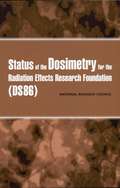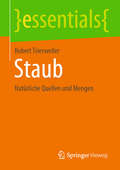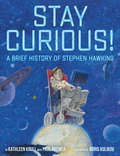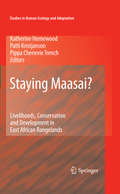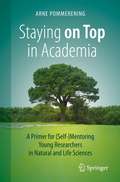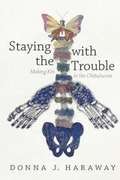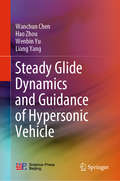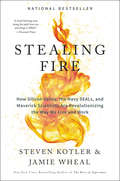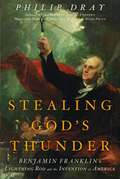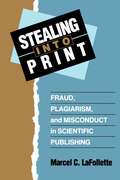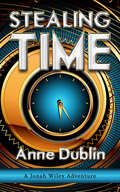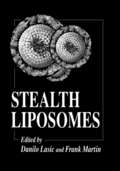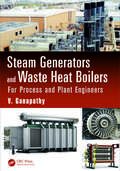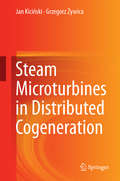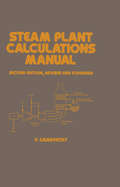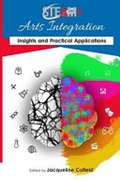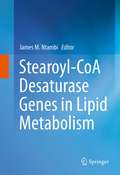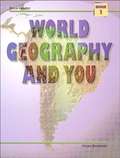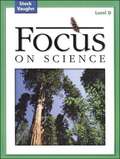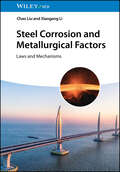- Table View
- List View
Status of the Dosimetry for the Radiation Effects Research Foundation (DS86)
by Committee on Dosimetry for the Radiation Effects Research FoundationThe Committee on Dosimetry for the Radiation Effects Research Foundation (RERF) was set up more than a decade ago at the request of the U.S. Department of Energy. It was charged with monitoring work and experimental results related to the Dosimetry System 1986 (DS86) used by RERF to reconstruct the radiation doses to the survivors in Hiroshima and Nagasaki. At the time it was established, DS86 was believed to be the best available dosimetric system for RERF, but questions have persisted about some features, especially the estimates of neutrons resulting from the Hiroshima bomb. This book describes the current situation, the gamma-ray dosimetry, and such dosimetry issues as thermal-neutron discrepancies between measurement and calculation at various distances in Hiroshima and Nagasaki. It recommends approaches to bring those issues to closure and sets the stage for the recently convened U.S. and Japan Working Groups that will develop a new dosimetry for RERF. The book outlines the changes relating to DS86 in the past 15 years, such as improved numbers that go into, and are part of, more sophisticated calculations for determining the radiations from bombs that reach certain distances in air, and encourages incorporation of the changes into a revised dosimetry system.
Staub: Natürliche Quellen und Mengen (essentials)
by Robert TrierweilerDieses essential beinhaltet Informationen zu den natürlichen Staubquellen, den unterschiedlichen Entstehungsprozessen und den Mengen der natürlichen Staubemissionen. Die Bildungsmechanismen von Primärpartikeln und Sekundärpartikeln werden beschrieben und die wichtigsten Präkursoren werden genannt. Daneben werden Schätzwerte für die globalen Emissionswerte von Primärpartikeln und Sekundärpartikeln sowie von Präkursoren zusammengetragen.
Stay Curious and Keep Exploring: 50 Amazing, Bubbly, and Creative Science Experiments to Do with the Whole Family
by Emily CalandrelliFrom the host of Netflix's Emily's Wonder Lab and FOX's Xploration Outer Space comes a book featuring 50 experiments that introduce the wonders of science to the whole family. MIT engineer Emily Calandrelli shares the science behind each experiment while showing you where to find STEAM concepts in the world around you. You'll learn how to think like a scientist with Make a Hypothesis! and Try This! prompts, where you can experiment within the experiment. With Calandrelli's expert guidance, illustrations throughout, and easy-to-find grocery items, you can make: An alien hovercraft to learn how an air hockey table worksGlow in the dark paint to learn about ultraviolet lightDelicious ice cream to learn about supercoolingOobleck to learn why ketchup is so hard to get out of the bottle With chapters like Magic Tricks, Kitchen Science, and Fun with Physics, this book is packed with experiments that will delight little scientists and their lab assistants. Grab your goggles and a family member to get started on a journey to spark curiosity, critical thinking, and fun family times!
Stay Curious and Keep Exploring: 50 Bigger, Bolder Science Experiments to Do with the Whole Family
by Emily Calandrelli#1 New York Times Best Seller The national-bestselling, must-have science experiment series is back! MIT engineer Emily Calandrelli, host of Netflix’s Emily’s Wonder Lab and FOX’s Xploration Outer Space, is taking curiosity to the next level with 50 big, bold, brand-new experiments that sparkle, bubble, and explode. With this follow-up to the national bestseller Stay Curious and Keep Exploring, scientists of all ages will have a blast learning about STEAM concepts, playing, discovering spectacular Did You Know? facts, and being introduced to Who to Know, diverse biographies of rock stars in the science and technology world. Using easy-to-find items you'll learn to think like a scientist and conduct jaw-dropping experiments, including: Color-changing slimes to discover if dogs really do see the world in black and white A glow-in-the-dark jellyfish to explore the science behind bioluminescence An unpoppable bubble to learn about why toothpaste never dries out Egg geodes to play with supersaturated liquids and crystallization And more! Get ready to explore subjects like Superhero Science, Kitchen Science Lab, and Science in Color. This latest installment of the Stay Curious and Keep Exploring series is sure to light sparks of curiosity and fuel a passion for science.EVERYONE LOVES EMILY: Common Sense Media calls Emily Calandrelli "the science teacher we all wish we had as young kids." And Bill Nye the Science Guy celebrated the first Stay Curious book with these words: "Here are 50, count 'em, 50 home experiments you can count on. Each is a crowd, or home experimenter, pleaser. Emily wrote this book for kids of all ages, and it’s full of references to women who changed the world—with science. It doesn’t matter where you start—be curious; open to any page; take some notes; Emily will keep you exploring." This new volume features 50 brand-new experiments to keep the fun and learning going. GREAT FOR SCIENCE FAIR & HOMESCHOOL CURRICULUM: A must-have for parents and homeschool educators! Colorful illustrations accompany every experiment, along with instructions and materials you'll need to get started, sections to record notes, and real-life examples connecting your STEAM experiment to the world around you. There are also fascinating facts about important people to know in science history. GIFT FOR SCIENCE KIDS & NON-SCIENCE KIDS: With experiments that use supplies that can be easily found at home or online, this book makes a fantastic gift for parents, kids, clubs, schools, and teachers for events from playdates and birthday parties to rainy-day indoor activities.Perfect for: Fans of Emily’s Wonder Lab, Emily Calandrelli and her social media channels, and Stay Curious and Keep Exploring looking for their next experiment book Parents, grandparents, caregivers, and teachers looking for engaging activities and STEAM projects for kids ages 5-12 Birthday, graduation, holiday, or summer activity gift for kids and families interested in science and encouraging STEAM learning Classroom guide or gift for teachers Readers of The Daring Book for Girls, The Dangerous Book for Boys, Geek Dad, and Awesome Science Experiments for Kids
Stay Curious!: A Brief History of Stephen Hawking
by Kathleen Krull Paul BrewerA picture-book biography about science superstar Stephen Hawking, whose visionary mind revolutionized our concept of reality and whose struggle with ALS inspired millions. Perfect for parents and teachers looking to instill curiosity and a love for STEM.As a young boy, Stephen Hawking loved to read, stargaze, and figure out how things worked. He looked at the world and always asked, Why?He never lost that curiosity, which led him to make groundbreaking discoveries about the universe as a young man. Even being diagnosed with ALS didn't slow Stephen down. Those questions kept coming. As his body weakened, Stephen's mind expanded--allowing him to unlock secrets of the universe and become one of the most famous scientists of all time.Stephen always approached life with courage, a sense of humor, and endless curiosity. His story will encourage readers to look at the world around them with new eyes.
Staying Maasai?
by P. Trench Patti Kristjanson Katherine HomewoodThe area of eastern Africa, which includes Tanzania and Kenya, is known for its savannas, wildlife and tribal peoples. Alongside these iconic images lie concerns about environmental degradation, declining wildlife populations, and about worsening poverty of pastoral peoples. East Africa presents in microcosm the paradox so widely seen across sub Saharan Africa, where the world's poorest and most vulnerable populations live alongside some of the world's most outstanding biodiversity resources. Over the last decade or so, community conservation has emerged as a way out of poverty and environmental problems for these rural populations, focusing on the sustainable use of wildlife to generate income that could underpin equally sustainable development. Given the enduring interest in East African wildlife, and the very large tourist income it generates, these communities and ecosystems seem a natural case for green development based on community conservation. This volume is focused on the livelihoods of the Maasai in two different countries - Kenya and Tanzania. This cross-border comparative analysis looks at what people do, why they choose to do it, with what success and with what implications for wildlife. The comparative approach makes it possible to unpack the interaction of conservation and development, to identify the main drivers of livelihoods change and the main outcomes of wildlife conservation or other land use policies, while controlling for confounding factors in these semi-arid and perennially variable systems. This synthesis draws out lessons about the successes and failures of community conservation-based approach to development in Maasailand under different national political and economic contexts and different local social and historical particularities.
Staying on Top in Academia: A Primer for (Self-)Mentoring Young Researchers in Natural and Life Sciences
by Arne PommereningThe pace of change in academia is ever increasing, which makes it difficult for anyone to stay up to date with what may be the right long-term strategy, or even the next step in mastering a PhD or to secure a fruitful academic career. Academic mentoring has proved to be helpful to many young researchers in difficult situations and mentoring programmes have been launched at many universities. In its most basic meaning, mentoring is a goal-oriented off-line conversation between a more experienced (mentor) and a less experienced (mentee) person with the objective to empower the mentee to make important work-related decisions. The first chapter of the book offers an introduction to academic mentoring and provides an overview of what academic mentoring entails. In the following chapters, important topics are discussed that may come up in mentoring conversations. These include scientific thinking, doctoral studies, behaviour and disappointments, scientific storytelling, teaching, scientific presentations, early career years, research cooperation, job applications and basic data management. The discussions in each of these chapters were designed with a view to provide food for thought and to invite self-reflection as well as continued discussions with peers and mentors. The book is written in a highly accessible style whilst restricting each chapter to the most essential information so that reading them can be accommodated in any busy schedule. It is not limited to any particular university or geographic region, since the author has worked in a number of different countries and encountered many different academic cultures. The text is also a useful handbook and reference to go with mentoring programmes.
Staying with the Trouble: Making Kin in the Chthulucene
by Donna J. HarawayIn the midst of spiraling ecological devastation, multispecies feminist theorist Donna J. Haraway offers provocative new ways to reconfigure our relations to the earth and all its inhabitants. She eschews referring to our current epoch as the Anthropocene, preferring to conceptualize it as what she calls the Chthulucene, as it more aptly and fully describes our epoch as one in which the human and nonhuman are inextricably linked in tentacular practices. The Chthulucene, Haraway explains, requires sym-poiesis, or making-with, rather than auto-poiesis, or self-making. Learning to stay with the trouble of living and dying together on a damaged earth will prove more conducive to the kind of thinking that would provide the means to building more livable futures. Theoretically and methodologically driven by the signifier SF--string figures, science fact, science fiction, speculative feminism, speculative fabulation, so far--Staying with the Trouble further cements Haraway's reputation as one of the most daring and original thinkers of our time.
Steady Glide Dynamics and Guidance of Hypersonic Vehicle
by Liang Yang Hao Zhou Wanchun Chen Wenbin YuThis book presents the latest researches on hypersonic steady glide dynamics and guidance, including the concept of steady glide reentry trajectory and the stability of its regular perturbation solutions, trajectory damping control technique for hypersonic glide reentry, singular perturbation guidance of hypersonic glide reentry, trajectory optimization based on steady glide, linear pseudospectral generalized nominal effort miss distance guidance, analytical entry guidance and trajectory-shaping guidance with final speed and load factor constraints. They can be used to solve many new difficult problems in entry guidance. And many practical engineering cases are provided for the readers for better understanding. Researchers and students in the fields of flight vehicle design or flight dynamics, guidance and control could use the book as valuable reference.
Stealing Air
by Trent ReedyYou can't just ask for the chance to fly . . .When his dad announced they were moving to Iowa, Brian looked forward to making some new friends. But on his first day there he makes an enemy instead -- Frankie Heller, the meanest kid in town. Brian needs to hang out with someone cool to get back on track. . . .Alex has always been the coolest guy around, and good with money, just like his dad. But now the family is struggling, and he needs to make some cash to keep up appearances. Then an opportunity falls in his lap . . . .Max is a scientific genius, but his parents are always busy with their own work. Building an actual plane should get their attention -- if only he wasn't scared of heights . . . The answer to all three boys' problems starts with Max's secret flyer. But Frankie and the laws of popularity and physics stand in their way. Can they work together in time to get their plan AND their plane off the ground?
Stealing Fire: How Silicon Valley, the Navy SEALs, and Maverick Scientists Are Revolutionizing the Way We Live and Work
by Steven Kotler Jamie WhealIt’s the biggest revolution you’ve never heard of, and it’s hiding in plain sight. Over the past decade, Silicon Valley executives like Eric Schmidt and Elon Musk, Special Operators like the Navy SEALs and the Green Berets, and maverick scientists like Sasha Shulgin and Amy Cuddy have turned everything we thought we knew about high performance upside down. Instead of grit, better habits, or 10,000 hours, these trailblazers have found a surprising short cut. They're harnessing rare and controversial states of consciousness to solve critical challenges and outperform the competition. New York Times bestselling author Steven Kotler and high performance expert Jamie Wheal spent four years investigating the leading edges of this revolution—from the home of SEAL Team Six to the Googleplex, the Burning Man festival, Richard Branson’s Necker Island, Red Bull’s training center, Nike’s innovation team, and the United Nations’ Headquarters. And what they learned was stunning: In their own ways, with differing languages, techniques, and applications, every one of these groups has been quietly seeking the same thing: the boost in information and inspiration that altered states provide. Today, this revolution is spreading to the mainstream, fueling a trillion dollar underground economy and forcing us to rethink how we can all lead richer, more productive, more satisfying lives. Driven by four accelerating forces—psychology, neurobiology, technology and pharmacology—we are gaining access to and insights about some of the most contested and misunderstood terrain in history. Stealing Fire is a provocative examination of what’s actually possible; a guidebook for anyone who wants to radically upgrade their life.
Stealing God's Thunder: Benjamin Franklin's Lightning Rod and the Invention of America
by Philip Dray"Dray captures the genius and ingenuity of Franklin's scientific thinking and then does something even more fascinating: He shows how science shaped his diplomacy, politics, and Enlightenment philosophy." -Walter Isaacson, author of Benjamin Franklin: An American Life. Today we think of Benjamin Franklin as a founder of American independence who also dabbled in science.
Stealing Into Print: Fraud, Plagiarism, and Misconduct in Scientific Publishing
by Marcel C. LaFolletteFalse data published by a psychologist influence policies for treating the mentally retarded. A Nobel Prize-winning molecular biologist resigns the presidency of Rockefeller University in the wake of a scandal involving a co-author accused of fabricating data. A university investigating committee declares that almost half the published articles of a promising young radiologist are fraudulent.Incidents like these strike at the heart of the scientific enterprise and shake the confidence of a society accustomed to thinking of scientists as selfless seekers of truth. Marcel LaFollette's long-awaited book gives a penetrating examination of the world of scientific publishing in which such incidents of misconduct take place. Because influential scientific journals have been involved in the controversies, LaFollette focuses on the fragile "peer review" process—the editorial system of seeking pre-publication opinions from experts. She addresses the cultural glorification of science, which, combined with a scientist's thirst for achievement, can seem to make cheating worth the danger. She describes the great risks taken by the accusers—often scholars of less prestige and power than the accused—whom she calls "nemesis figures" for their relentless dedication to uncovering dishonesty.In sober warning, LaFollette notes that impatient calls from Congress, journalists, and taxpayers for greater accountability from scientists have important implications for the entire system of scientific research and communication.Provocative and learned, Stealing Into Print is certain to become the authoritative work on scientific fraud, invaluable to the scientific community, policy makers, and the general public.
Stealing Time: A Jonah Wiley Adventure
by Anne DublinThrown back in time by a mysterious pocket watch, Jonah and his stepbrother, Toby, are forced to overcome their differences and work together to return to the present. Jonah Wiley is having a tough time. First, his parents divorced, and now his mom is going to a conference and leaving him with his dad and stepmother. But after Jonah steals an antique pocket watch, he and his stepbrother Toby are hurled back in time — to Egypt, China, France, and other places around the world. In order to save themselves and get back to the present, Jonah and Toby must overcome their personal issues and work together to solve the tough problems they encounter.
Stealth Liposomes (Handbooks in Pharmacology and Toxicology #20)
by Danilo Lasic and Frank MartinThis book examines stealth liposomes from a multidisciplinary approach, which includes theoretical polymer physics, organic synthesis, colloid science, and biology. Discussions include theory, chemistry, biochemistry, pharmacology, preclinical studies in model systems, and medical applications in humans.
Steam Generators and Waste Heat Boilers: For Process and Plant Engineers (Mechanical Engineering)
by V. GanapathyIncorporates Worked-Out Real-World ProblemsSteam Generators and Waste Heat Boilers: For Process and Plant Engineers focuses on the thermal design and performance aspects of steam generators, HRSGs and fire tube, water tube waste heat boilers including air heaters, and condensing economizers. Over 120 real-life problems are fully worked out which wi
Steam Microturbines in Distributed Cogeneration
by Jan Kiciński Grzegorz ŻywicaThis book presents the most recent trends and concepts in power engineering, especially with regard to prosumer and civic energy generation. In so doing, it draws widely on his experience gained during the development of steam microturbines for use in small combined heat and power stations based on the organic Rankine cycle (CHP-ORC). Major issues concerning the dynamic properties of mechanical systems, in particular rotating systems, are discussed, and the results obtained when using unconventional bearing systems, presented. Modeling and analysis of radial-flow and axial-flow microturbines are addressed in detail, covering rotor analysis with different bearing systems, simulation modal analysis, and stress analysis. Furthermore, experimental studies of the dynamic properties of microturbine elements are extensively described. Interest in distributed generation and CHP-ORC is growing rapidly, and the potential market for such systems promises to be very large. This book will be of value for engineers and scientists involved in the design, modeling, operation, and diagnostics of various types of turbomachinery, especially steam microturbines.
Steam Plant Calculations Manual, Revised and Expanded (Mechanical Engineering #87)
by GanapathyMaintaining a question-and-answer format, this second edition provides simplified means of solving nearly 200 practical problems that confront engineers involved in the planning, design, operation and maintenance of steam plant systems. Calculations pertaining to emissions, boiler efficiency, circulation and heat transfer equipment design and performance are provided. Solutions to 70 new problems are featured in this edition.
Steam+ Arts Integration Anthology: Insights and Practical Applications
by Jacqueline CofieldThe 12 contributors featured in this anthology are on the frontlines of STEAM+ Arts Integration Education and include engineers, educators, leaders/founders of STEM and STEAM education programs, teaching artists, and cultural programmers. The book provides a historical summary of STEM to STEAM, case studies, and practical program examples used in classrooms across the country and abroad. A unique resource that includes charts and images displaying a wide range of perspectives and insights to enlighten educators and readers on why STEAM+ Arts Integration is the wave of the future.
Stearoyl-CoA Desaturase Genes in Lipid Metabolism
by James M. NtambiObesity and diabetes develop as a complex result of genetic, metabolic and environmental factors and are characterized by increased lipogenesis and lipid accumulation in many tissues. Stearoyl-CoA desaturase (SCD) genes are a critical regulator of lipogenesis and catalyzes the synthesis of monounsaturated fatty acids (MUFA), mainly oleoyl- (18:1n9) and palmitoleoyl-CoA (16:1n7). These MUFAs are the major fatty acid substrates for the synthesis of triglycerides, cholesterol esters, wax esters and membrane phospholipids. There are 4 SCD isoforms (SCD1-4) in mice and two (hSCD1 and hSCD5) expressed in humans. At first glance, stearoyl-CoA desaturase enzyme would be considered a housekeeping enzyme because it synthesizes oleate a well-known fatty acid that is abundant in many dietary sources. However numerous studies have shown that SCD is a very highly regulated enzyme that features in so many physiological processes ranging from fat differentiation, carbohydrate and fat metabolism, inflammation and cancer. The editor's studies using stearoyl-CoA desaturase knockout (SCD1-/-) mice and studies of other investigators using pharmacological approaches to reduce SCD1 expression in mouse tissues have all established that the expression of SCD1 gene isoform represents a key step in partitioning of lipids between storage and oxidation. High SCD expression favors fat storage leading to obesity while reduced SCD expression favors fat burning and leanness. Although these studies clearly illustrated that SCD1 expression is involved in the development of obesity and insulin resistance, questions remain in the elucidation of the mechanisms involved and role of SCD1. This book includes chapters by leading researchers on SCD Genes in the brain, heart, muscle, liver metabolism, Colitis, and more.
Steck-Vaughn Focus on Science (Level D)
by Elizabeth MaryottThis book puts complete focus on basic science and covers various topics under Life science,Earth science Energy etc.
Steck-Vaughn Science: Test Preparation for the 2014 GED
by Steck-Vaughn CompanyThe newest edition of the GED test presents a range of fresh challenges to learners and educators. Now Houghton Mifflin Harcourt offers you an accelerated yet complete approach to deliver positive test results faster with Steck-Vaughn Test Preparation for the 2014 GED Test.
Steel Corrosion and Metallurgical Factors: Laws and Mechanisms
by Chao Liu Xiaogang LiExploration into the latest research and developments in material corrosion resistance and related technologies Steel Corrosion and Metallurgical Factors: Laws and Mechanisms offers an in-depth exploration of the latest research on modulating metallurgical factors in various types of steel materials to enhance their corrosion resistance. The book covers a diverse range of materials, including low-alloy steels, stainless steels, ductile iron, rebar, and pipeline steel, and outlines the application of corrosion big data technology and artificial intelligence in the revealing of material corrosion mechanisms. The book discusses how typical metallurgical factors such as inclusion control, alloying control, and heat treatment control influence the corrosion resistance of stainless or low alloy steels and provides theoretical guidance for corrosion-resistant steel smelting technologies (e.g., inclusions regulation, alloy modulation, and rolling processes) by investigating the laws and mechanisms underlying the influence of various metallurgical factors on the corrosion resistance of steel. Steel Corrosion and Metallurgical Factors includes information on: Micro- chemical-electrochemical theory of corrosion initiation induced by various typical types of inclusions in stainless and low alloy steelsInfluence of elements such as Ca, Sb, Cu, and Cr on the resistance of low-alloy steels to microbial and marine atmospheric corrosionCoupled mechanism of microstructure and inclusions in corrosion initiation in steelBehavior and mechanism of stress corrosion and hydrogen-induced stress corrosion of pipeline steel induced by environmental and metallurgical factorsEffects of rare earth and chromium elements on the corrosion resistance of HRB400 rebar in concrete environmentsMetallurgical defects on ductile iron corrosion mechanisms and corrosion big data-artificial intelligence techniques in revealing factors influencing material corrosion Steel Corrosion and Metallurgical Factors strongly supports metallurgical and materials researchers and engineers in developing new corrosion-resistant steels.
Steel Heat Treatment: Equipment and Process Design
by George E. TottenOne of two self-contained volumes belonging to the newly revised Steel Heat Treatment Handbook, Second Edition, this book focuses on process design, equipment, and testing used in steel heat treatment. Steel Heat Treatment: Equipment and Process Design presents the classical perspectives that form the basis of heat treatment processes while
